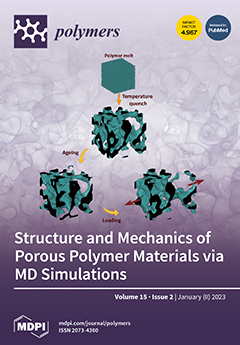Recently, there is a need to explore the utilization of various heterostructures using the designed nanocomposites and tuning the surfaces of electrodes for improving the electrochemical performance of supercapacitors (SC). In this work, a novel approach is successfully employed through a facile two-step
[...] Read more.
Recently, there is a need to explore the utilization of various heterostructures using the designed nanocomposites and tuning the surfaces of electrodes for improving the electrochemical performance of supercapacitors (SC). In this work, a novel approach is successfully employed through a facile two-step synthetic route with the assistance of a microwave for only 1 min. Depending on the glass transition of a polystyrene (PS) substrate and electrochemical deposition (ECD) of electroactive Ni-Co layered double hydroxides (LDHs), a hierarchically designed flake-like morphology can be readily prepared to enhance the surface-active sites, which allows a rhombohedral Ni-Co LDHs electrode to obtain superior electrochemical properties. Further, the interactions between electrode and electrolyte during the diffusion of ions are highly simplified using multiple enhanced electroactive sites and shorter pathways for electron transfer. The unique surface architecture of the PS substrate and the synergistic effect of the bimetallic components in Ni-Co LDHs enable this substrate to obtain desired electrochemical activity in charge storage systems. The optimized MWC Co
0.5Ni
0.5 electrode exhibited an areal capacity of 100 µAh/cm
2 at a current density of 1 mA/cm
2 and a remarkable capacity retention of 91.2% over 5000 continuous charging and discharging cycles due to its remarkable synergistic effect of abundant faradaic redox reaction kinetics. The HSC device is assembled with the combination of optimized MWC Co
0.5Ni
0.5 and activated carbon as a positive and negative electrode, respectively. Further, the electrochemical test results demonstrated that MWC Co
0.5Ni
0.5 //AC HSC device showed a high areal capacitance of 531.25 mF/cm
2 at a current density of 5 mA/cm
2. In addition, the fabricated an aqueous HSC device showed a power density of 16 mW/cm
2 at an energy density of 0.058 mWh/cm
2, along with the remarkable capacity retention of 82.8% even after 10,000 continuous charging and discharging cycles. Moreover, the assembled hybrid supercapacitor (HSC) device is integrated with a triboelectric nanogenerator (TENG) for the development of energy conversion and storage systems. Not only an extensive survey of materials but also an innovative solution for recent progress can confirm the wide range of potential SC applications. Remarkably, this study is a new way of constructing self-powered energy storage systems in the field of sustainable wearable electronics and future smart sensing systems.
Full article






